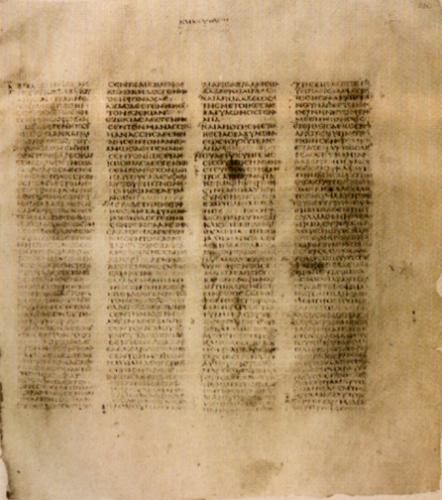Cracking the Codex

Dan Wallace over at Parchment and Pen has a rundown of some of the mistakes that were made by the media when covering this momentous occasion. Some of his points are stronger than others. For instance, he criticizes the ubiquitous headline reference to "the world's oldest Bible" because it's only the world's oldest complete New Testament. He's completely right on the point but since the Codex Sinaiticus web site advertises itself as "the oldest Bible," it's hard to complain that the media took that ball and ran with it. But his comprehensive list shows how facts are sometimes sacrificed in the rush to make ancient news sound more interesting.
Here's part of the New York Daily News account:
The text was written on vellum, a type of animal hide, and the pages that have survived include the entire New Testament and the earliest surviving copy of the Gospels, written after Christ's death by Matthew, Mark, Luke and John.
But, Wallace notes:
No, there are several manuscripts, especially papyrus fragments, that are older: P52 (c. 100-150 CE, thus a good 200 years older than Sinaiticus) contains five verses from John's Gospel; P66 (c. 175 CE) contains most of John; P75 (early third century) contains most of John and Luke; P45 (third century) contains large portions of all four Gospels, etc. There are well over twenty papyri that are both older than Sinaiticus and have portions of at least one of the Gospels. In addition, Codex B has the complete Gospels and is probably older than Sinaiticus.
Or take this reference to the Shepherd of Hermas and the Epistle of Barnabas from The Independent (UK):
It includes two works which have since been dropped from both Catholic and Protestant Bibles . . .
Wallace responds:
This presupposes that these books were considered canonical in the fourth century. But that is doubtful in the extreme. It is, in fact, doubtful whether such books would have been considered scripture at any time by a majority of Christian churches. That they are under the same cover as the OT and NT does not necessarily indicate that they were regarded as scripture, especially since we have no corroborating evidence to suggest this. In the least, the reason why Barnabas and Hermas are within Sinaiticus's covers is open to more than one interpretation.
The same article also confuses how a verse from the Gospel of Mark is rendered in Sinaiticus with how it is rendered in the Codex Bezae, writes Wallace. And it says:
The Codex omits the words which Protestants add to the end of The Lord's Prayer, and Catholics omit: For thine is the kingdom, and the power, and the glory, for ever (Matthew 6:13).
But, as Wallace notes, it's not on the basis of most "modern" translations that Protestants use these words. It's based on how the King James Version was translated. (And it neglects to mention that these words are part of the Orthodox Divine liturgy of St. John Chrysostom and that they have been part of the Roman Catholic mass at various points in its history)
Here's another funny error:
You might suppose it would upset those who believe the Bible is the inerrant, unaltered word of God, since the Codex shows there have over the centuries been thousands of alterations to today's Bible. But they can counter that there are earlier, individual manuscripts of almost all the books in the Bible; the Codex just pulls them together into a single volume. In any case, fundamentalists have long been adept at ignoring the evidence of historical biblical scholarship.
Well! Wallace responds:
A whole host of faulty assumptions occur in this paragraph, such as that inerrantists and fundamentalists are synonymous, that the changes made to the codex in later centuries can have any impact on one's belief in the inerrancy of the autographs, that the whole issue of canonicity is in some way altered by this codex, or even that knowledge of this manuscript is only now coming to light. All this really shows is that the author is ignorant of both inerrantists and Sinaiticus.
Wallace also highlights some media errors from CBC (Canada), The Guardian and CNN. Sometimes it takes an expert in the issue area to critique the media coverage. I'm glad Wallace listed some of the larger errors for posterity.